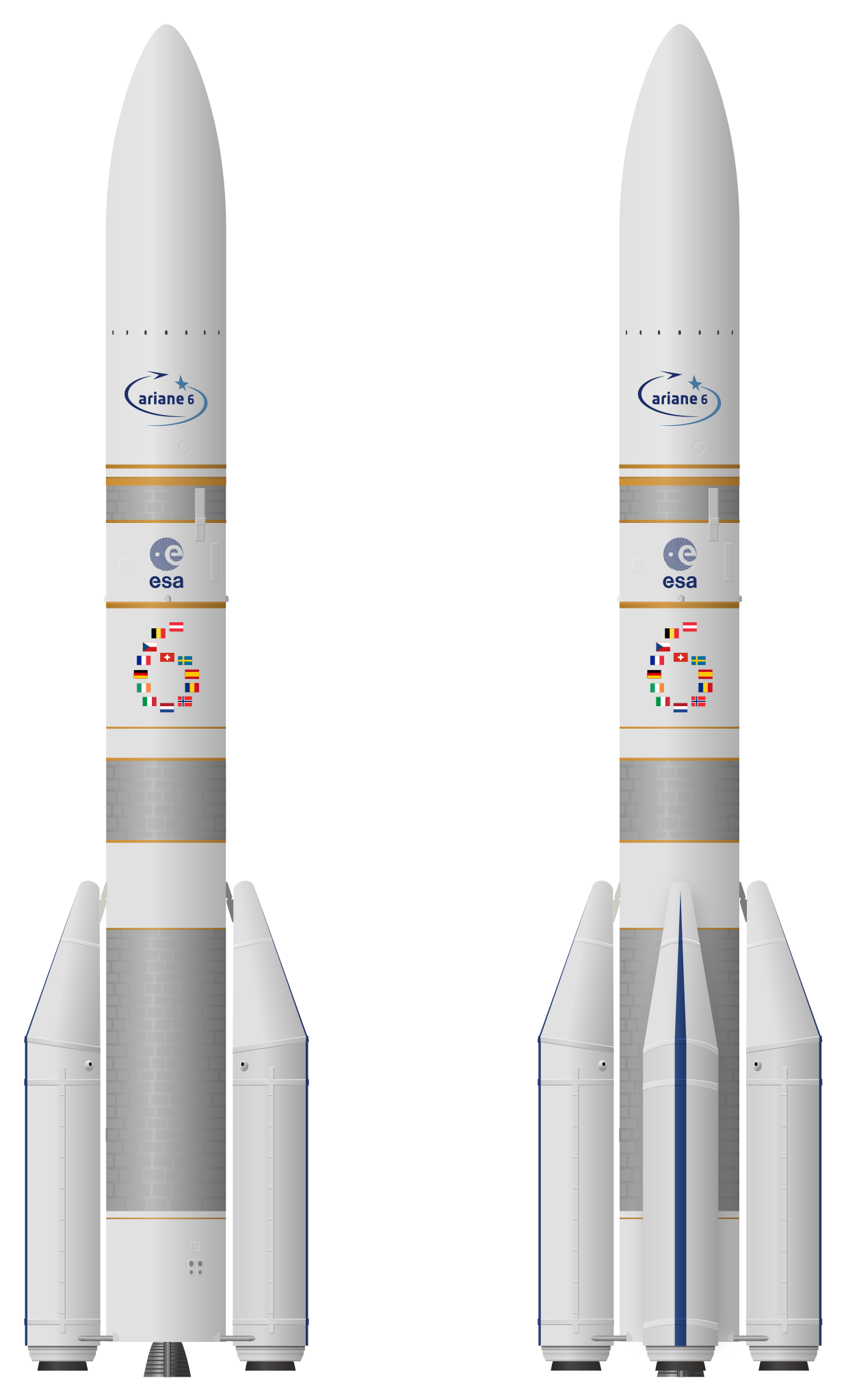Ariane 6
 Both variants of Ariane 6: with two (left) and four (right) solid rocket boosters. Photo Credit : SkywalkerPL, via Wikipedia commons. https://en.wikipedia.org/wiki/File:Ariane_62_and_64.svg
Both variants of Ariane 6: with two (left) and four (right) solid rocket boosters. Photo Credit : SkywalkerPL, via Wikipedia commons. https://en.wikipedia.org/wiki/File:Ariane_62_and_64.svg
Ariane 6 is a European expendable launch system currently under development by ArianeGroup on behalf of the European Space Agency (ESA).
Quick Facts About Ariane 6.
- Type: Medium-heavy launch vehicle.
- Origin : European Space Agency.
- Manufacturer: ArianeGroup.
- In service : Currently in development expected late 2022.
- Mass : 530,000–860,000 kg (1,170,000–1,900,000 lb).
- Length/Height : 63 m (207 ft).
- Diameter : 5.4 m (18 ft).
- Payload to LEO : A64: 21,650 kg (47,730 lb). A62: 10,350 kg.
- Payload to GTO : A64: 11,500 kg (25,400 lb). A62: 5,000 kg (11,000 lb).
- Payload to SSO : A64: 14,900 kg (32,800 lb). A62: 6,450 kg (14,220 lb).
- Propellant: Boosters: Solid. First/Second stage : LH2 / LOX
- Engines: Boosters : 2 or 4 P120 with a thrust of 4,500 kN (1,000,000 lbf). First stage: Vulcain 2.1 with thrust of 1,370 kN (310,000 lbf). Upper stage : Vinci with thrust of 180 kN (40,000 lbf).
Ariane 6 is a European expendable launch system currently under development by ArianeGroup on behalf of the European Space Agency (ESA). It is intended to replace the Ariane 5, as part of the Ariane launch vehicle family. The stated motivation for Ariane 6 is to halve the cost compared to Ariane 5, and double the capacity for the number of launches per year (from six to twelve).
Ariane 6 is designed with two core stages both powered by liquid hydrogen-liquid oxygen (hydrolox) engines. The first stage has an improved version of the Vulcain engine already used on the Ariane 5, whilst the second stage has a newly-designed Vinci engine. Most of the initial lift-off thrust is provided by solid rocket boosters attached to the first stage: either two or four P120s (Ariane 62 and Ariane 64 variants respectively), which are larger versions of the P80s used on the Vega rocket.
Selection of the design concept was made by ESA in December 2014, favouring it over an alternative all-solid-fuel rocket option. Further high-level design was completed in 2015 and the vehicle entered the detailed design phase in 2016. Arianespace placed the first production order in May 2019. The first test flight was initially scheduled for 2020, but following several delays is now expected late 2022.
Two variants of Ariane 6 are being developed: Ariane 62, with two P120 solid boosters, will weigh around 530 t (520 long tons; 580 short tons) at liftoff and is intended mainly for government and scientific missions. It can launch up to 5,000 kg (11,000 lb) into GTO:33 and 10,350 kg (22,820 lb) into LEO.45 Ariane 64, with four P120 boosters, has a liftoff weight of around 860 t (850 long tons; 950 short tons) and is intended for commercial dual-satellite launches [9] of up to 11,500 kg (25,400 lb) into Geosynchronous transfer orbit (GTO) :33 and 21,500 kg (47,400 lb) into LEO. 46 Like Ariane 5, it will be able to launch two geosynchronous satellites together.
Credit/References and for further info please see:
https://en.wikipedia.org/wiki/Ariane_6